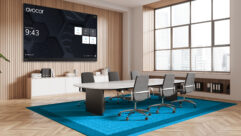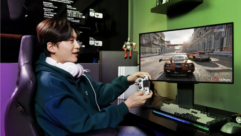
Installation Profile: Civic Display
Jun 1, 2007 12:00 PM,
By Jay Ankeney
Innovative videowall technology helps promote Kentucky tourism affordably.
Web Expanded
Click here to see a diagram of the installation

The attention-grabbing new video-wall in Louisville, Ky.’s Visitors Information Center uses eight Samsung 460PN LCD screens to display classic Kentucky footage to entice visitors to take a closer look. Photo by Chris Fieldhouse
There’s a new attraction in downtown Louisville, Ky., that serves as a colorful, one-stop promotion for virtually all of Kentucky’s tourist destinations — an eight-screen videowall in the window of the Louisville Convention & Visitors Bureau’s (LCVB) new Visitors Information Center. On its own, the integrated 2×4 multipanel display has become a major attention-grabber for the LCVB. But, beyond that fact, the innovative technology behind the videowall has the potential to make this kind of signage much more affordable than ever before.
The videowall’s design is the brainchild of Troy McCormick, owner of Natural Concepts, a museum-consulting and exhibit-design firm located in Jeffersonville, Ind. “This videowall display was designed to be part of the LCVB’s interpretive exhibits in their new Visitors Information Center,” McCormick says. “The rest of the installation includes, among other presentations, a history of Colonel Harland Sanders’ Kentucky Fried Chicken enterprise and a trip down Kentucky’s famous Bourbon Trail. But it’s the videowall that draws passersby to the visitor center’s windows.”
AFFORDABLE PLAYER
The LCVB first approached Natural Concepts in July 2006 to create a facility to replace the original Visitors Bureau’s storefront souvenir shop that sat adjacent to the convention center. The design process for the project lasted until the end of last year.
“In one of our meetings with the LCVB, the board members told us they wanted to make this downtown corner the Louisville equivalent of Times Square,” McCormick says. “We started by looking at a large 52in. corner monitor to showcase video footage of Kentucky events and festivals, but decided we needed something bigger and better.”
A videowall can obviously provide a more exciting look than a single screen, but the existing technology to manage a multipanel videowall could easily top $150,000 for just the hardware and software required, and that number far exceeded the LCVB’s budget. However, the Visitors Information Center’s board was attracted to a videowall’s potential for displaying the many iconic images associated with the Bluegrass State. Visions of Kentucky Derby horses racing around the corner installation as if it were the stretch turn at Churchill Downs, or the Belle of Louisville paddle wheeler cruising the bend in the videowall as if it were the majestic Ohio River made the whole concept appealing to the board.
For a solution, McCormick turned to Brian Nutt, president of Louisville-based Captive Indoor Media (CIM), which specialized in digital signage systems for financial institutions.
“We came into this project late in the game, after the Visitors Information Center’s board had been rocked by sticker shock from other vendors, and we knew this videowall had to be designed for ease of use and efficient operation,” Nutt says. “So we came up with a player that would cost only $30,000 and could be controlled from any remote laptop.”
The player concept Nutt came up with is part of CIM’s Codigo software line, based on web client architecture. Greg Klopper, CIM’s director of software development, was the project’s software engineer. He used Adobe’s Flex programming language on a Windows XP computer. “I used Flex to create a Flash-based output as an interface for scheduling the programming on the videowall, as well as managing the media library and to oversee the multiple displays’ operations,” Klopper says. “The original Codigo single-screen software was what attracted the LCVB to us, but the more we talked with them, we realized they needed a very specific new application that would address the needs of multiple screens. So what we created was a standalone module for this project that could include the capture of live video streams. Although this was developed specifically for the Louisville videowall project, eventually this will become part of our new 2.0 line of Codigo software.”
Instead of sending out video signals for eight separate displays from two four-head cards, CIM’s server design feeds out just two VGA displays and lets the videowall’s own processing power divide it into two sets of four displays.
With its timeline-based scheduling component, the Codigo software lets the programming director access a web portal to upload new media into the player’s Flash memory and create a playlist from any location with a web connection. The software has built-in functions that schedule file transfer for times when Internet bandwidth is most available, such as off-peak hours late at night, to prevent monopolizing the Visitors Information Center’s web connection.
Nutt’s player controls the eight Samsung 460PN screens on the videowall. The videowall system can be programmed to show several different layers of video with state logos or product IDs superimposed over them. The advertising potential could someday become a resource for financial supporters of the visitor center, but for now, the LCVB is limiting the display to tourist attractions and announcements.
CONTENT CREATION
For the display’s content, McCormick’s team called on William Tyler Thomas, owner of Jeffersonville, Ind.-based Bright Ideas Creative. The team provided Thomas with a standard-definition Beta SP compilation reel of events, activities, and beauty shots from Louisville and Kentucky in general, and he used Apple Final Cut Pro 5.1 on a 1.8GHz dual-processor Mac Pro to edit together selected shots.
Then, to get the LCVB board’s approval of the content before the eight-screen videowall even existed, Thomas imported an eight-panel mask created in Adobe Photoshop into Final Cut Pro and positioned the selected video within those eight windows. That version mimicked the wall’s 32:9 aspect ratio (double 16:9) to simulate a mock-up of the eight screens as they would wrap around the Visitors Information Center’s corner location.
This matrix was then burned onto a DVD so the board members could view it in their offices and give feedback about which images they wanted to use. The board also had to evaluate whether the content of the selected scenes would be distracting. After all, they wanted the videowall to become a visual highlight of the downtown Louisville scene, but they didn’t want to disrupt the flow of traffic.
Once the edit was approved, Thomas took each scene and rendered it out in Adobe After Effects in the necessary pixel dimensions to fit the screens on the videowall.
“Although I could specify which picture should appear on a given screen, it was up to Captive Indoor Media’s software to either position specific images on individual displays or stretch them across several screens,” Thomas says. “So I would do the renders in QuickTime, encode them in Flash video, and send them via FTP to Captive Indoor Media’s software.”
In order to spread a single image across multiple displays, Thomas had to deal with huge files in terms of pixel dimensions, which sometimes required enormous amounts of compression.
“A scene that may have been only 12 seconds long would be 1GB in size, but I would compress them down to just 8MB of Flash video,” he says.
INTEGRATION
Steve Bean, sales engineer at Louisville-based CIM Audio Visual, oversaw the project’s systems integration, which included several interactive touchscreen plasma displays as well as the corner videowall’s eight Samsung 460PN (1366×768) LCD screens.
CIM Audio Visual designed the multi-screen corner wall exhibit so it could be detached and moved away from the wall for maintenance and upgrades. All cable management and connectivity to the displays is accessible from the rear and concealed by two public greeting E-card computer workstations on the interior side of the exhibit.
“In addition to the installation, we did all the screen calibration and determined the type of display adapters they would need,” Bean says. “Although the videowall is programmed by Captive Indoor Media’s software, all of the other screens are operated by an AMX customized software control system with the wireless Modero ViewPoint touchpanel that we installed. This lets the Visitor Information operators tailor their content to specific exhibits in the center. Although the other displays in the center are turned off at 9 p.m., the videowall stays on around the clock.”
When the new Visitors Information Center was finished, the results exceeded the expectations of the LCVB board. “We were lucky to have such a unique and capable resource from a local company like Captive Indoor Media,” says Garry Cronin, VP of finance and administration for the LCVB. “Captive Indoor Media custom-built this application for us and delivered it with player hardware and all of the features and functionality we wanted for a very affordable price.”
The new Visitors Information Center had its grand opening in February of this year. “There was no comparison of Captive Indoor Media’s software and hardware combination with what I would have previously done using existing video cubes and management software,” McCormick says. “Bringing this videowall in at less than $50,000 for software, hardware, and display screens means that almost any city could afford an attraction like this.”
The buzz generated in downtown Louisville by this project has continued to grow. “The client was so excited about the videowall’s impact that they immediately started asking about the potential to enhance it with up to four additional screens,” McCormick says. “As a result, we are currently pricing out the ability to expand it from eight to 12 monitors.”
In addition, in May, the project team added a live cable feed to the videowall that enabled people on the sidewalk in front of the Visitors Information Center to view the Kentucky Derby live for the first time.
Tourism represents a significant portion of Kentucky’s economy. With cost-saving technology and techniques such as those used on the Visitors Information Center project enabling new cutting-edge display possibilities for civic displays, similar attractions may soon be coming to a city near you.
For More Information
Adobe
www.adobe.com
Apple
www.apple.com
AMX
www.amx.com
Captive Indoor Media
www.captiveindoormedia.com
Samsung
www.samsung.com
Jay Ankeneyis an industry consultant and former TV network engineer living in the Los Angeles area.









